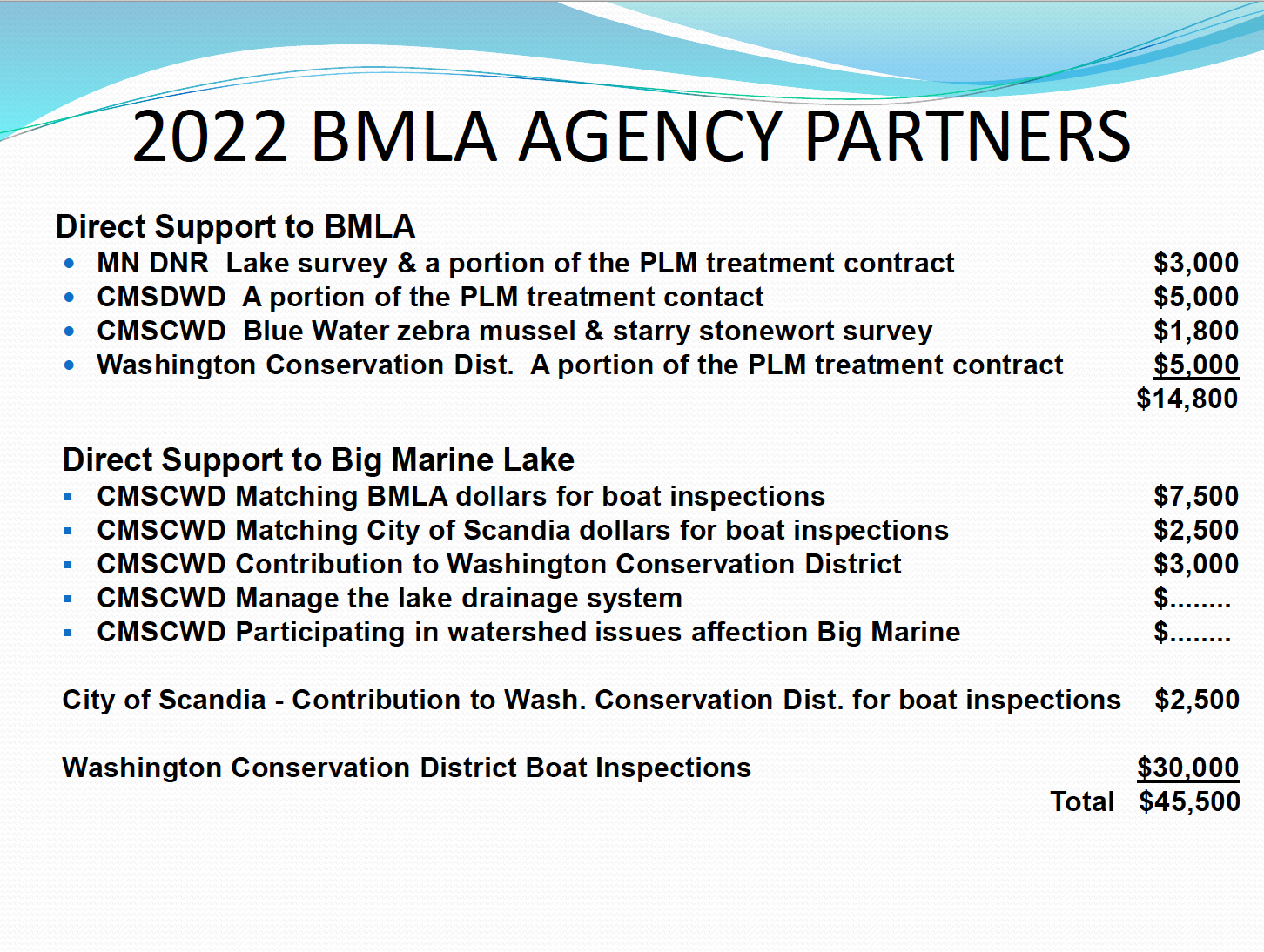FAQs-AIS
How do we survey and treat Eurasian Water Milfoil?
What was the original lake vegetation management plan for BML?
What was the year by year herbicide treatment of BML?
What is the composite of treatments from 2009 through 2019?
What was the summary of EWM treatment funded by the Initiative Foundation?
What are key non-profit organizations working on AIS and other lake issues?
What governmental agencies are assisting with BMLA AIS control and BML inspection activities?
How is watercraft inspection for AIS in Washington County handled?
What are the summaries of watercraft inspections by the WCD?
What effects do herbicides have on native vegetation?
Why has the east bay of BML not seen major patches of EWM?
What is the MAISRC narrow leaf cattail project all about?
What is the starry stonewort story?
Are weevils a viable way of controlling EWM?
What effect does sediment have on EWM?
What is an example of a grant application?
How do we survey and treat Eurasian Water Milfoil?
Survey/Treatment Process:
In the spring, the lake is surveyed by the BML, recording all waypoints having EWM growth. The data is transmitted to the DNR via GPS software
BWS (Blue Water Science) began assisting the BMLA with monitoring in 2015.
DNR representative resurveys the EWM growth in the lake.
DNR advises PLM (our licensed herbicide applicator) and BMLA of approved areas for treatment.
BMLA applies for DNR grant funds.
PLM treats the lake.
Treated areas are resurveyed for results of the herbicide treatment.
Surveying continues in to the spring of the next year.
What was the original lake vegetation management plan for BML?
A plan was prepared in a 16 page document for the MN DNR on 11/2/09. That plan can be viewed on this website at About/Survey and Research Info/LVMP 11.02.09.
What was the year by year herbicide treatment of BML?
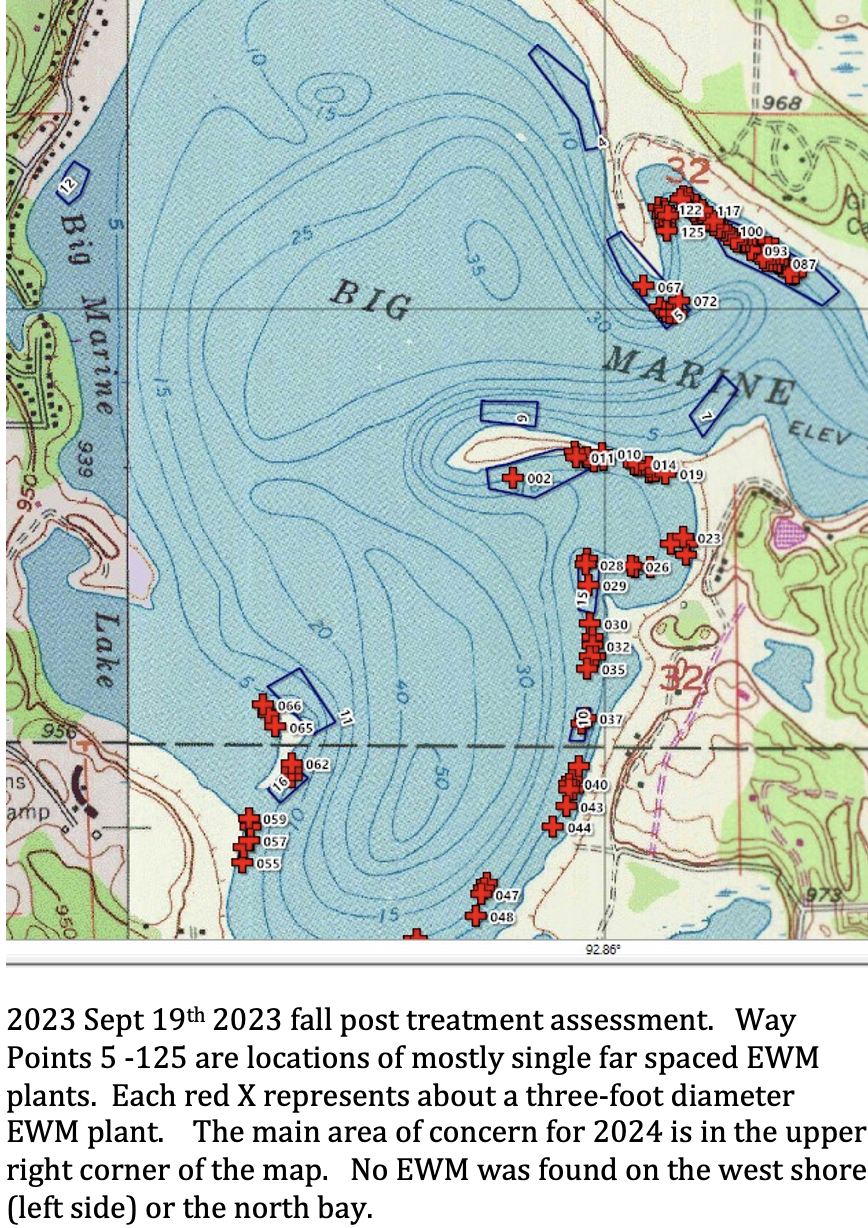
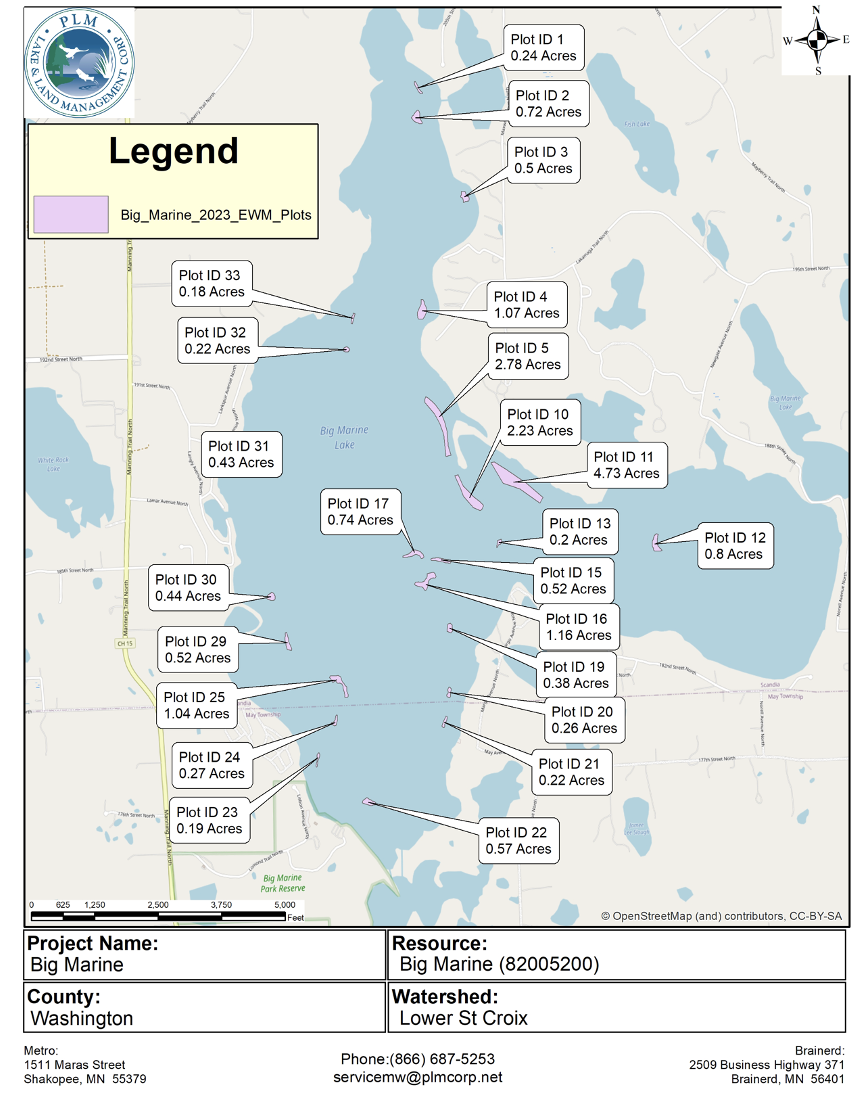
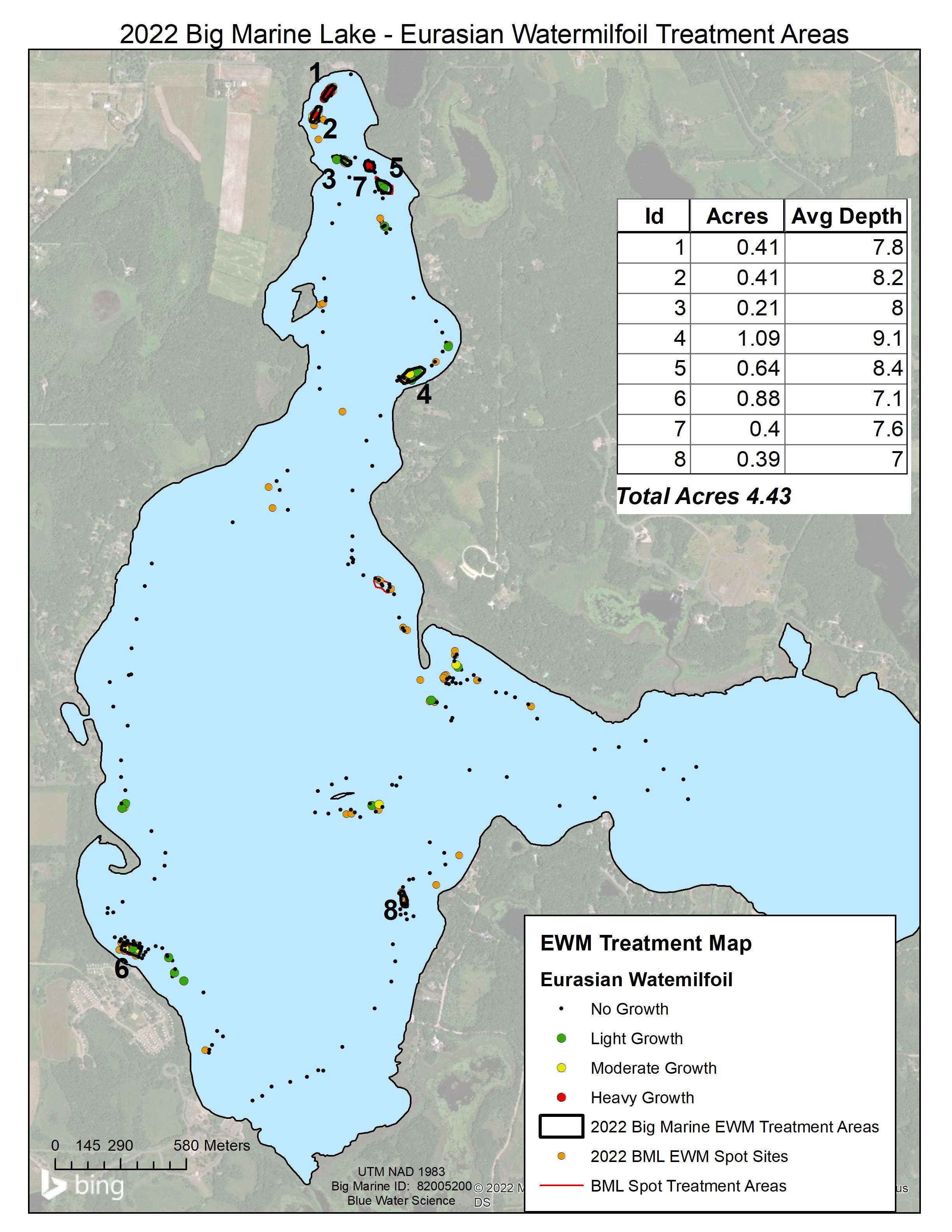

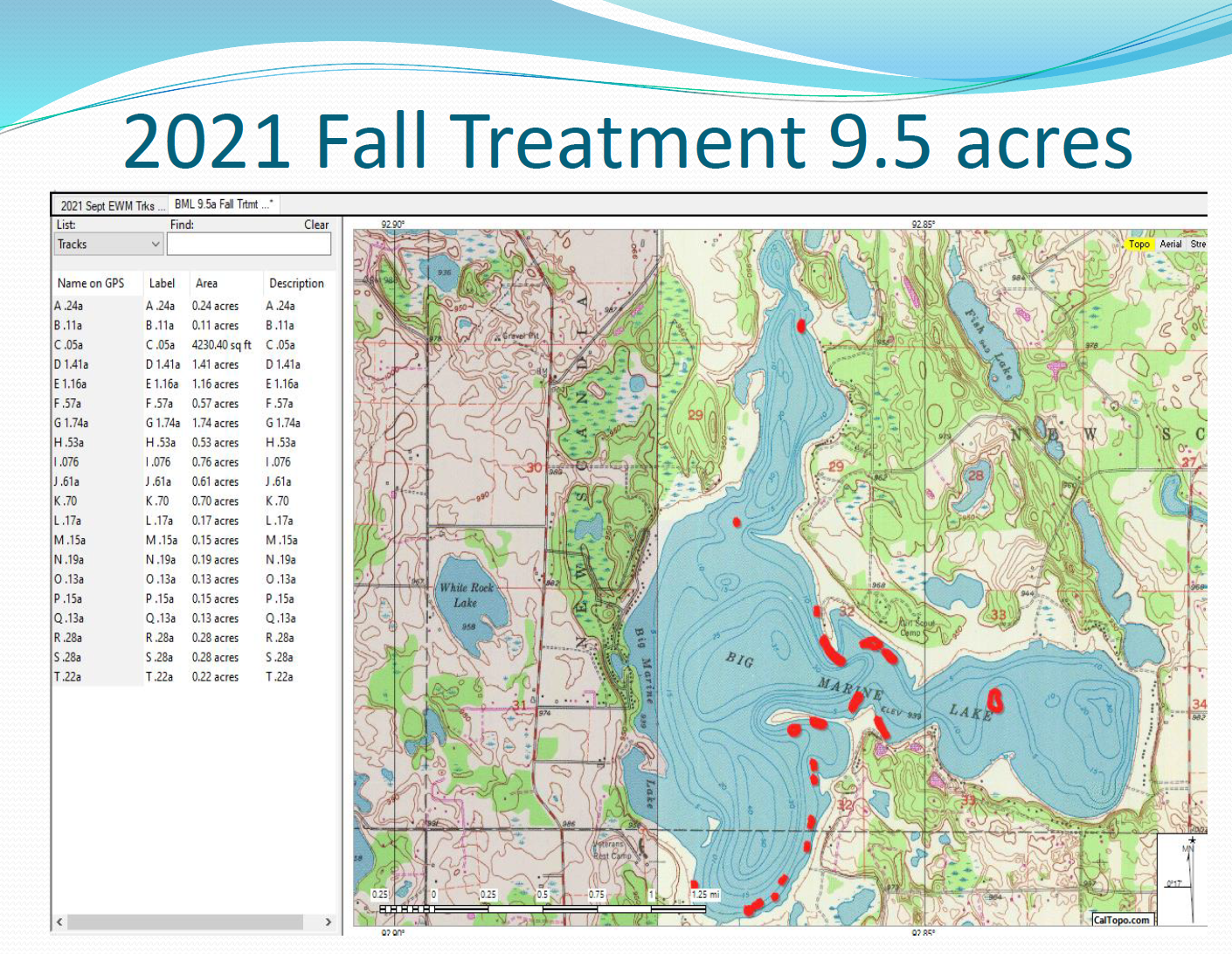
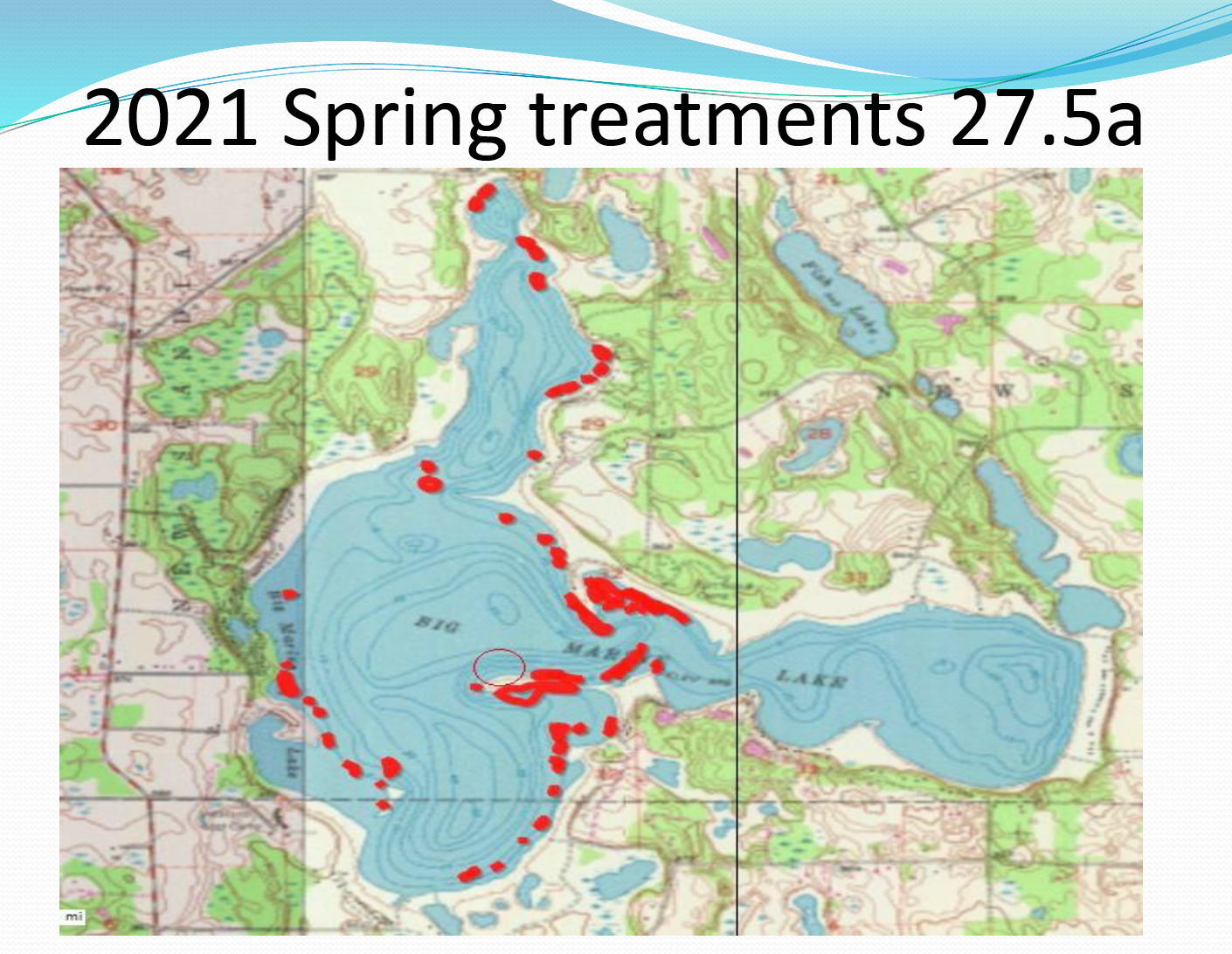
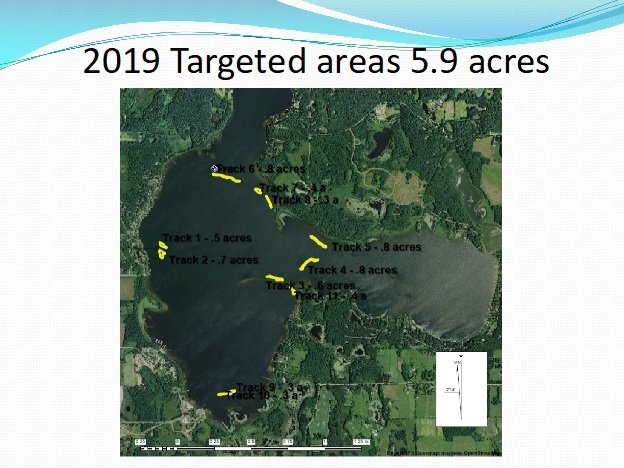
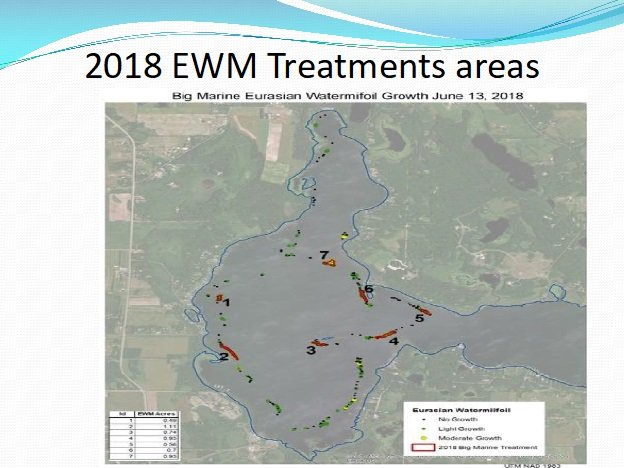


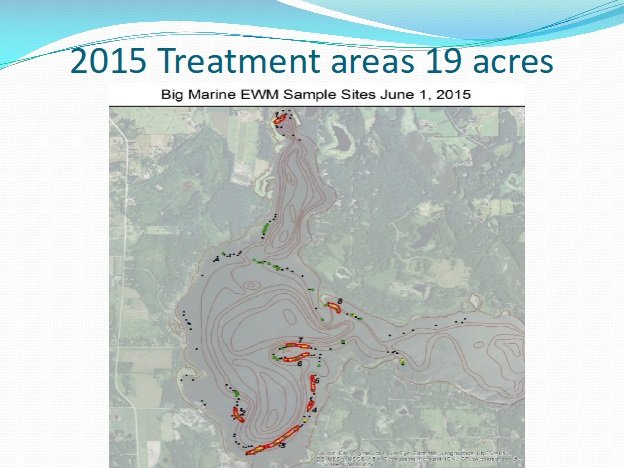
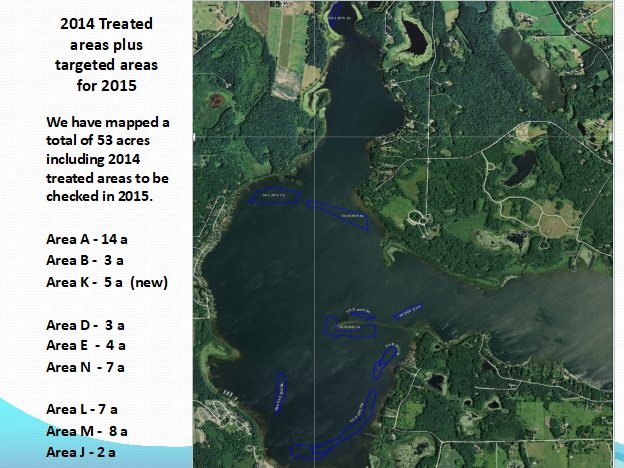
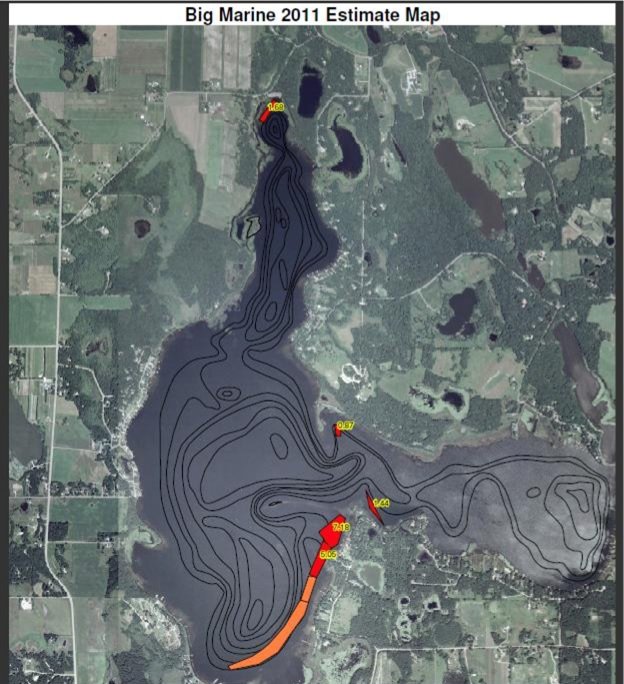
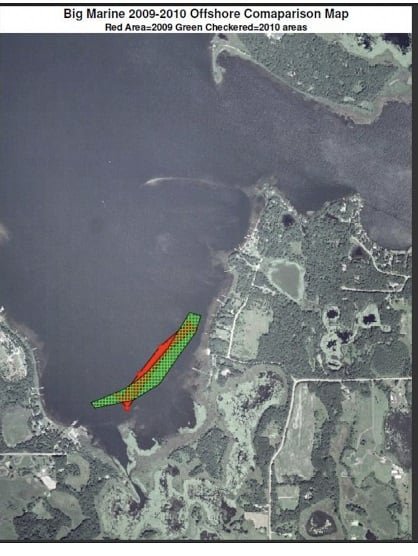
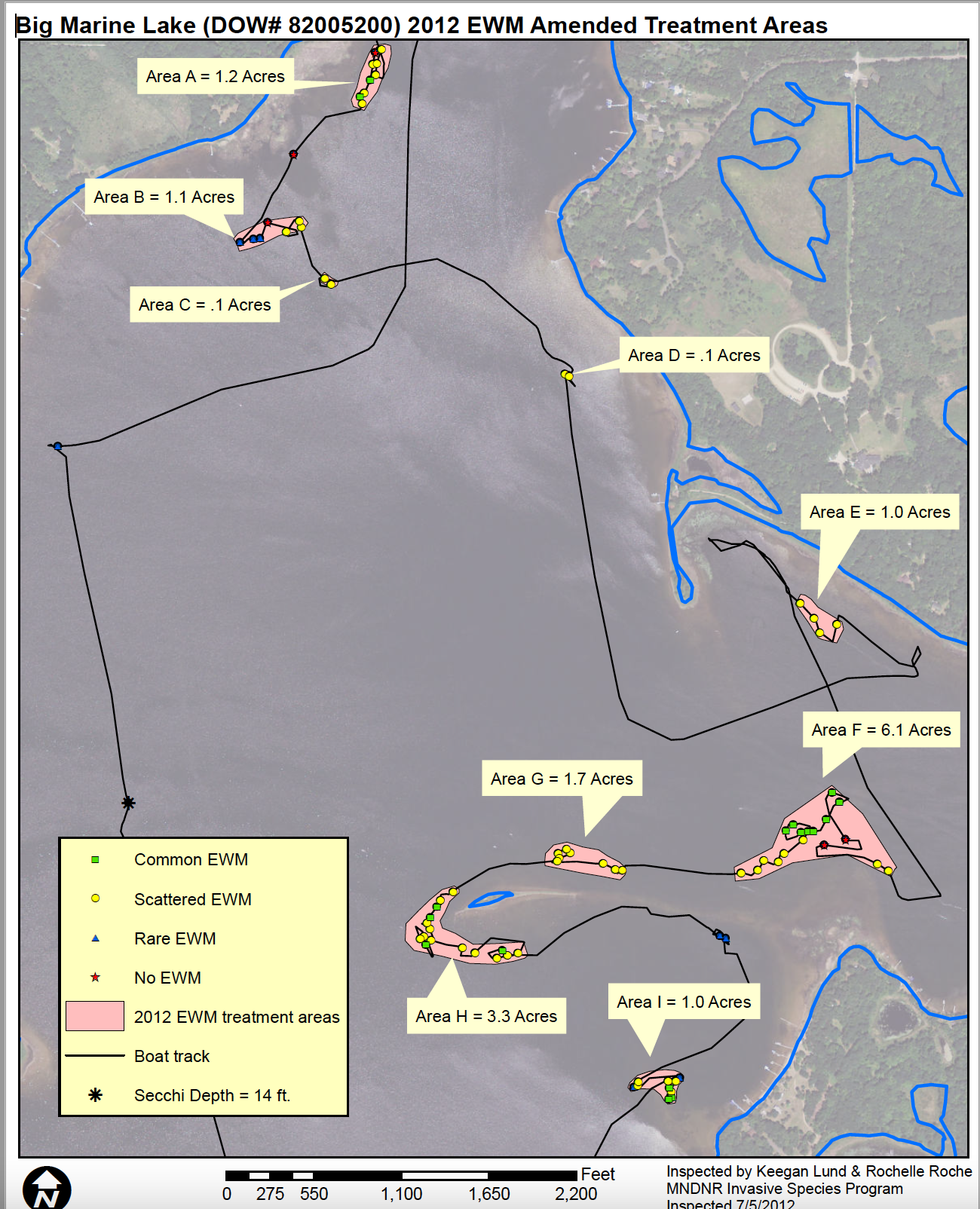
The following chart illustrates the acres we’ve treated in past years to control/kill EWM:
Acres Treated by Year
Detailed summaries of lake survey information have been recorded each year—These summaries are used to compile data about specific treatment areas on lake maps.
What is the composite of treatments from 2009 through 2019?
If the BMLA lets down our guard, the 2009 to 2019 BML EWM Treatments Composite map below shows what could happen to BML. It would actually be worse since the map doesn’t show all the spots in the east bay (west of the channel connecting east and west ends of the lake) where the BMLA has spot treated every year. Sediment testing done during the winter of 2014 found that the lake can support at least 300 acres of EWM and this map shows what it would look like if the BMLA wasn’t aggressively working to kill it.
The BMLA has been able to accomplish control and killing of EWM via:
Increasing our membership and membership contributions.
Seeking and receiving grants every year since 2009.
Generating ideas and procedures that have enabled the BMLA to kill rather than just control EWM. These new methods take significant volunteer time to implement and cost more than traditional EWM treatment.
These ideas, new protocols, and hundreds of volunteer hours have been the basis for obtaining all of the grant funding which will total about $120000 by the end of 2019.
Developing our own equipment to treat small spots of EWM. BMLA has been spot treating every year in addition to the licensed applicator treatments. We were the first lake association the DNR permitted to do our own spot treating.
Developing our expertise in surveying and mapping the locations and defining the shape of the EWM polygons (areas).
BMLA Board members have attended numerous seminars and developed good relationships with people in the AIS field including the DNR, PLM Lake and Land Management Corp (our herbicide application contractor), Blue Water Science (consultant Steve McComas), Minnesota Lakes and Rivers Advocates (MLRA), MAISRC (U of M Aquatic Invasive Species Research Center), and the CMSCWD (Carnelian Marine St. Croix Watershed District).
Methods used:
Multiple herbicide treatments in 24 hours to help insure that the dose remains high (in the kill zone) long enough to kill rather than just weaken the EWM.
Direct herbicide injection into the EWM root balls.
Having PLM apply the new herbicide, ProcellaCor, which kills EWM with a shorter dwell time than previous herbicides, on many small areas in 2019. It is difficult to kill small areas because even a small drift in the water column moves the herbicide off target.
The plan is to have PLM apply a contact herbicide in mid-to-late August, 2019 on EWM that is still growing. A contact herbicide only kills the leafy green portion of the plant. There is anecdotal evidence that if the leafy portion of the plant is killed late in the season, the inability to photosynthesize will starve the roots so they will not survive the winter. The herbicide will also kill the leafy green “EWM rootlets” which self-fracture and spread EWM to other parts of the lake.
If the BMLA wasn’t active:
The east west channel would fill in with EWM.
The Girl Scout Camp would be surrounded by EWM and the passage to the north bay would be blocked.
There would be a ring of EWM around the entire main bay and around the island.
About 30% of both the east and west shores of the north bay would have EWM, plus the two small yellow dots in the north end would connect across the bay if the BMLA had not spot treated in those areas. The composite map doesn’t show this spot treating.
What was the summary of EWM treatment funded by the Initiative Foundation?
The following report was furnished to the Initiative Foundation in late 2019 to summarize work done by the BMLA which was made possible by IF grants and other funding.
The BMLA’s goal since 2009, and finally realized at the start of 2015 with support from the Initiative Foundation, was to implement new procedures to “kill” not just “control” EWM. Reducing the amount of EWM in Big Marine Lake from about 40 to 5 or less acres has been expensive and time consuming. And in addition to a healthier lake with an abundance of native plant species, the amount of herbicide used has been reduced by about a factor of 10.
Read about our success with the IF Grant in Issue 37 of our Newsletter.
What are key non-profit organizations working on AIS control and other lake issues?
In addition to supporting the BMLA, financial support is also much needed for other organizations which have been very crucial in furthering the AIS cause and other issues of concern for BML. Refer to their websites for additional information.
Minnesota Lakes and Rivers Advocates
P.O. Box 22262
St. Paul, MN 55122
Phone: 952-854-1317
jeff@mnlakesandrivers.org
MLRA is the main channel for getting the message from lake associations to the MN Legislature. They were a major factor in the 2014 passage of legislation which funded money to the counties for AIS work.
Comments about MLRA (2022)
Membership is a huge issue for this organization. Despite recent successes in their efforts with regard to numerous issues critical to waterfront property owners, MLRA has really struggled to increase individual members. With more members, they would have greater impact. MLRA would greatly appreciate any help they can get from lake and river associations.
MLR is leveraging membership contributions to benefit the BMLA, for example. They lobbied to create the MAISRC (Minnesota Aquatic Invasive Species Research Center), then lobbied to fund the capital investment to upgrade the lab, and in 2021 lobbied successfully for $910k annually to provide baseline funding to cover the day-to-day operations of the MAISRC. Ditto with aquatic plant management efforts-MLRA lobbied successfully for the $4.5 million in AIS Innovations Grants that the Initiative Foundation managed. BMLA received about $48000 in grants from the IF and made good use of those funds. In the last legislative session MLRA successfully lobbied for $850k in AIS management grants. BMLA benefited from use of some of those funds. All these actions by MLR should cause more people to see that a membership in MLR is an investment with a good return on investment.
To donate to MLRA CLICK HERE
MLRA is an extension of the efforts of the BMLA and the BMLA is an extension of the efforts of MLRA.
Minnesota Aquatic Invasive Species Research Center (MAISRC)
2003 Upper Buford Circle, Skok Hall 135
St. Paul, MN 55108
This organization funded by the MN Legislature is doing critical research work to further the science of AIS and find solutions to myriad existing and future AIS issues. It also is in need of additional support in the form of private citizen financial help.
Notes from the September 2022 on-line seminar presented by MAISRC
Minnesotans for Family Fishing and Healthy Lakes
This group with a lobbyist at the MN Legislature was a significant influence in putting a hold on Muskie stocking proposed by the DNR and opposed by numerous lake associations and individuals.
What governmental agencies are assisting with BMLA AIS control and BML inspection activities?
The above slide shows that the Carnelian Marine St.Croix Watershed District, the Washington Conservation District, the City of Scandia, and the MN DNR have all been partners in addressing BMLA aquatic invasive species work. Grants from the Initiative Foundation in previous years, mentioned in another FAQ -AIS, also would be considered agency support, as would grants from Washington County.
The Washington Conservation District (WCD)
The WCD is a countywide local unit of government in Washington County responsible for conducting water quality monitoring on lakes and streams; educating and assisting landowners in installing lake-improvement projects like shoreline plantings and raingardens; conducting watercraft inspections in Washington County and public education about AIS.
One function of WCD is managing AIS watercraft inspection at public launch sites in Washington County. WCD is a special purpose local unit of government created in 1942 to protect and conserve natural resources in Washington County. The WCD is a Soil and Water Conservation District per State Statutes 103C and has an elected board. It does not have its own taxing authority. Funding comes from a variety of sources: Federal, State, County, and local. Currently, around 60% of funding comes from local partnerships (mostly with Watershed Organizations), 20% from the County, and 20% from the State. This funding varies from year to year. The total budget is a little over $2.2 million with a focus on providing technical and educational services as well as financial incentives to implement voluntary conservation practices. Main program areas are Watershed and WCD Administration (two watershed administrators are employees of the WCD), Water Monitoring, Education/Outreach, Planning and Prioritization, Conservation Technical Assistance, Invasive Species Management, and BMP (Best Management Practices) Maintenance.
The County received $140,000 in funding in 2020 from the State for Aquatic Invasive Species (AIS) work. Of this, WCD was granted almost $75000. It was spent on education and outreach ($5000); inspection ($50000); rapid response ($4500); enforcement, oversite, and other areas ($13000). Parking stalls at public accesses dictate how inspection $ are allocated. Inspection is done per a formal agreement between Carnelian Marine St. Croix Watershed District (CMSCWD) and WCD. Total inspection hours completed by WCD were 1115 at BML. A grant from CMSCWD to WCD covered 500 hours of added inspection at BML. A portion of these added hours was covered by a donation by BMLA of $2500 which CMSCWD matched. For 2021 funding to WCD from CMSCWD (including the 2021 match from BMLA) could cover about 350 hours of inspection more than in 2020 – estimated 1450 hours total.
Further details about WCD:
WCD watercraft inspections and lake monitoring:
Matt Downing (no longer with WCD in 2023)
651-330-8220
Ext.29
matt.downing@mnwcd.org
East Metro Water Resource Education Program:
Angie Hong
651-330-8220 Ext.35
angie.hong@mnwcd.org
The East Metro Lakes Network conducts workshops and publishes information on such things as shoreline protection through their Water Resource Education Program.
Visit the WCD website, including a section about the EMLN - www.mnwcd.org/emwrep
Carnelian Marine St. Croix Watershed District
The CMSCWD has assisted in providing added funding for launch site watercraft funding as noted in the WCD FAQ above. A 10-Year Plan developed by the CMSCWD will address countless issues pertaining to the overall health of all waters in the district.
The CMSCWD was recognized as 2023 Watershed District of the Year by the Minnesota DNR. The award was presented to CMSCWD staff and board members at the 2023 Minnesota Watersheds Annual Conference in Alexandria, MN. For details on this award see an article in the December 27, 2023 Country Messenger. https://www.countrymessenger.com/eedition
11660 Myeron Rd N, Stillwater, MN 55082
Office: (651) 433-2150
Administrator
Mike Isensee
mike.isensee@cmscwd.org
Direct Line: (651) 275-7451
Or: (612) 839-6492.
Visit the CMSCWD website
Minnesota Department of Natural Resources
The DNR has helped with AIS technical information exchanges and surveying BML for the presence of native vegetation. They have also provided grants to the BMLA for EWM control.
Keegan Lund has been the main contact at the DNR for AIS treatment issues:
MN DNR
500 Lafayette Road
St. Paul, MN 55155
Keegan Lund: (651) 259-5828
E-mail: Keegan. Lund@state.mn.us
The DNR contact for grants is:
Jake Walsh, Ph.D. (he/him)
Aquatic Invasive Species Research & Grants Coordinator | Ecological & Water Resources
Minnesota Department of Natural Resources
500 Lafayette Road
St. Paul, MN 55155
Cell Phone: 651-724-2439
Email: Jake.Walsh@state.mn.us
Visit the MN DNR website mndnr.gov
Washington County Public Health & Environmental Department
Grant applications are filed with this county department. The BMLA has received many annual grants from Washington County, including in 2022. The funds for those grants come from Legislative action in 2014 which calls for distribution of funds to counties to be used for AIS work.
The County conducts a continuing series of Water Consortiums to which the BMLA is always invited. These conferences deal with a wide range of County water-related issues.
The grant administrator is:
Tom Dietrich | Planner II
Pronouns: he, him, his
Washington County Public Health & Environment
14949 62nd Street North, Stillwater, MN 55082
651-430-6716
The contact for the Water Consortiums is Stephanie.Souter@co.washington.mn.us
How is watercraft inspection for AIS in Washington County handled?
All watercraft inspections for AIS at public accesses within Washington County are done under the auspices of the Washington Conservation District (WCD). Inspections are performed at all public accesses on BML. The WCD hires and schedules the trained inspectors.
How can I become an inspector?
Inspectors must be authorized. The only way a person can be a volunteer inspector is to be trained by the DNR to become an “AIS Ambassador” (AA). A negative of AA volunteers is that they cannot be overseen by the WCD. Also, an AA does not have authority to prevent a watercraft from launching. Oversite is necessary for the WCD to be able to track hours worked, schedule work hours, and collect data. Another option for a private individual to do inspection is to train with WCD to be a paid inspector. The problem in that case is that assignments cannot be guaranteed to always be at BML public accesses.
Conclusion: Volunteering to be an inspector by a person representing the BMLA is not just a matter of going to a BML public access and looking for AIS on watercraft.
What are the summaries of watercraft inspections by the WCD?
Summary of Inspection for 2023
What effects do herbicides have on native vegetation?
Native plants are flourishing in BML. The DNR deems that a minimum of 12 native plant species are needed for healthy lake diversity. The DNR has recorded 23 to 29 native species when surveyed three times since 2014. The DNR has stated that the EWM treatments have not caused any harm and that BML has excellent clarity and a healthy and diverse plant community. In fact, since EWM was typically killed early in the season the same year that it was found, native plants which sprout later than EWM immediately filled the void.
Results of so-called Point Intercept surveys by the DNR vary from year to year since some of the native species are rare and might get missed since the points tested are 150 feet apart. There are also many native plants near the shore that may not be consistently counted (they count submersed plants and in August, the ones near shore may not be submersed at that time). About five years ago the DNR surveyor noticed a long line of plants very near shore mixed in with the cat tails for about 800 feet along the southwest end of the east bay. They have a stem of purple flowers that rise about one foot above the water and broad arrow shaped leaves. They might be called Arrow Root. The DNR person was amazed to see so many since they are somewhat rare and highly prized in back yard water gardens. He said that if someone is caught pulling them up, there is a large fine.
Below are the historical results for BML for submersed species including EWM. The data is per a report based on a survey done August 6, 2020 by Keegan Lund and Kylie Cattoor of the MN DNR. No surveys were performed in 2021 or 2022. The DNR Invasive Species Program completed their 2023 Aquatic Vegetation Report for Big Marine, the report is based on an on water point-intercept survey conducted on August 23, 2023. The short summary is Big Marine is a great lake….healthy, good plant diversity, decent clarity and blessed with an active and effective lake association!! There are a few minor items; 2020 treatment was 3-6 acres not .6 as reported. The date of the survey was shortly after the 2023 EWM treatment, so the die back of EWM was at it’s peak resulting in minimal EWM and best possible outcome……. we probably look a little better than actual, but forget that…it looks GREAT! The report was not yet posted on the MN DNR website as of March 22, 2024.
The trend in Big Marine Lake has been more natives as the EWM and Curly Leaf Pondweed (CLP) have been killed. CLP was treated only once in about 2015. Treatment of CLP was planned to be repeated for about three years in a row, but was not because the first treatment worked so well.
Why has the east bay of BML not seen major patches of EWM?
In 2021 the question came up as to why the east bay of BML has not seen large, dense patches of EWM. A possible explanation of this fact is that the sediment in the east bay is not as conducive to EWM propagation as in other parts of the lake. A sediment analysis by Blue Water Science, however, did not necessarily show any distinct difference in sediment makeup is various parts of the lake. Another possible reason is that EWM had not sufficiently spread to the east bay by the time the BMLA initiated herbicide treatments and that the licensed applicator treatments in the main lake and BMLA spot treating in the east bay have held EWM in check. Lastly, most of the east bay is fairly shallow as compared to the rest of BML. The native vegetation in those shallower waters could be a significant deterrent to EWM taking root.
What is the MAISRC narrow leaf cattail project all about?
Broad leaf cattail is a native species which has been the dominant cattail in BML. Sometime in recent years an invasive cattail, narrow leaf has taken over. Broad leaf grows with space between plants. Narrow leaf has a very dense growth pattern, a pattern which causes very low oxygen levels. These low oxygen levels do not support fish reproduction except for carp and bullheads. Broad leaf cattail is good habitat for fish. MAISRC has a project started in 2021 on nine Minnesota lakes which is attempting to find ways of enhancing fish reproduction in the presence of the narrow leaf cattail.
So far, they have found that removal by cutting below the water line in swathes about 50 feet wide allows the needed fish habitat. The problem in the long run, however, is how to keep these areas clear of the narrow leaf cattails. Who will pay for the work? Who will do the clearing? Also, if water level drops to below the top of the cut cattail, it will grow back. Secondly, adjacent narrow leaf plants will grow to fill in the cut swath. The bottom line is that ongoing narrow leaf cattail control can and/or will be a never ending process.
Following is a MAISRC information card for the project.
Also, see the report on the cattail project from the September 2022 on-line seminar presented by MAISRC.
What is the starry stonewort story?
A breakout session at the MN Lakes and Rivers Advocates Aquatic Invaders Summit III on March 1, 2018 dealt with Starry Stonewort (SSW). The session began with a presentation by Kevin Farnum of the Lake Koronis Association. The amount of work and the amount of money spent by LKA has been astronomical compared to many other AIS projects we have heard of. SSW was first found in Lake Koronis in 2015 and was treated that year. Lake Koronis is 3000 acres with about 1200 littoral acres.
What does this mean for the BMLA?
SSW is a real threat to all lakes in Minnesota. It will be the responsibility of lake associations to monitor their lakes and to prevent any new AIS invasion. The BMLA will need to maintain a cash reserve in case a new AIS is found in BML because a rapid response will be required and only the BMLA will be able to make a rapid response.
The Carnelian Marine St. Croix Watershed District granted the BMLA $1400 to be used for two scuba diving inspections of BML by Blue Water Science, one in early July, 2018 and another in September, 2018. The inspections will be searches for SSW and zebra mussels. Anyone who scubas is welcome to join in these inspections. BWS will train you at the time of the inspection.
Are weevils a viable way of controlling EWM?
Weevils for EWM Control
The 7/31/2018 BMLA newsletter included a positive report from the MN Lakes and Rivers Advocates about work being done to control EWM by introducing weevils into EWM infestations. While it is notable that this research is currently being done, it also needs to be noted that much work with weevils has been done in the past at great expense with no good conclusions. The weevils were extremely difficult to raise and when introduced into a lake were quickly eaten by sunfish.
What effect does sediment have on EWM?
Blue Water Science did a sediment survey on BML in the winter of 2014/2015 as part of efforts to learn more about EWM. The nutrients in sediment do have an impact on the ability of EWM to take root and survive well. In a 9/2/2022 article in Outdoor News magazine, Steve McComas of BWS commented about some revelations he had regarding EWM and sediment.
A new sediment analysis is tentatively planned for 2023. To be targeted are areas which have continued to have EWM even though they have been treated numerous times. A sediment survey could provide insight into a way to reduce the return of EWM or lead to alternate herbicides, different herbicide dosages, or multiple treatments. Also, if the chemical content of the sediment is determined to contribute to excess growth of EWM, perhaps the sediment can be modified.
Following is the article “Missing Milfoil” containing his comments:
What is an example of a grant application?
What contractors are the BMLA using?
For herbicide treatment of Eurasian Water Milfoil BMLA has worked for many years with PLM, a licensed applicator.
Our main contact has been Patrick Seller, VP Minnesota Operations.
PLM Lake and Land Management Corp.
2509 MN 371 Business
Brainerd, MN 56401
and
1511 Mara St.
Shakopee, MN 55379
Phone for both locations: 866-687-5253 or 651-383-1150
For lake surveying for EWM, searching for zebra mussels and Starry Stonewort, sediment studies, and help with herbicide treatment permitting the BMLA has worked with Blue Water Science.
Our contact with BWS is Steve McComas, The Lake Detective.
Blue Water Science
550 Snelling Ave. S. #101
St. Paul, MN 55116
Phone: 651-690-6902
Not a member? If you find this information useful, please consider supporting our efforts.

